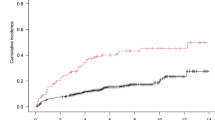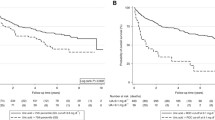Abstract
Rituximab reforms the treatment of diffuse large B-cell lymphoma (DLBCL) and the prognostic significance of baseline patient features should be reevaluated. Few population-based studies have investigated the association of diabetes mellitus (DM) and outcomes of lymphoma; however, the results remain inconclusive. From January 1, 2000 to December 31, 2009, a total of 468 consecutive newly diagnosed DLBCL patients receiving first-line chemotherapy with cyclophosphamide, vincristine, doxorubicin, and prednisolone (CHOP) or rituximab plus CHOP (R-CHOP) were enrolled. Pre-existing DM was defined according to medical history, use of antidiabetic medications, or any record of an abnormal hemoglobin A1c test. Progression-free survival (PFS) and overall survival (OS) were estimated and compared using the Kaplan–Meier method with a log-rank test. CHOP was administered in 194 patients, and 274 patients received R-CHOP. DM was identified in 16.2 % (76/468) of patients. Diabetic patients were older and more performance restricted, compared to the non-DM patients in both the CHOP and R-CHOP groups. In the CHOP group, 5-year PFS and OS were inferior in DM patients (PFS, 32.4 vs. 50.0 % (P = 0.039); OS, 38.2 vs. 62.5 % (P = 0.002)). However, outcomes were similar for both DM and non-DM patients in the context of R-CHOP treatment (PFS, 69.0 vs. 57.3 % (P = 0.179); OS, 76.2 vs. 69.8 % (P = 0.586)). The response rate of chemotherapy in DM patients was also improved to a level similar to non-DM patients with rituximab use. In conclusion, the prognostic significance of preexisting DM in DLBCL patients is changing in the rituximab era. The potentially additional benefit of rituximab in DM patients merits further investigation.


Similar content being viewed by others
References
Lenz G, Staudt LM (2010) Aggressive lymphomas. N Engl J Med 362:1417–1429
The International Non-Hodgkin’s Lymphoma Prognostic Factors Project (1993) A predictive model for aggressive non-Hodgkin’s lymphoma. N Engl J Med 329:987–994
Coiffier B, Thieblemont C, Van Den Neste E et al (2010) Long-term outcome of patients in the LNH-98.5 trial, the first randomized study comparing rituximab-CHOP to standard CHOP chemotherapy in DLBCL patients: a study by the Groupe d'Etudes des Lymphomes de l'Adulte. Blood 116:2040–2045
Sehn LH, Berry B, Chhanabhai M et al (2007) The revised International Prognostic Index (R-IPI) is a better predictor of outcome than the standard IPI for patients with diffuse large B-cell lymphoma treated with R-CHOP. Blood 109:1857–1861
Bari A, Marcheselli L, Sacchi S et al (2010) Prognostic models for diffuse large B-cell lymphoma in the rituximab era: a never-ending story. Ann Oncol 21:1486–1491
Tay K, Tai D, Tao M et al (2011) Relevance of the International Prognostic Index in the rituximab era. J Clin Oncol 29:e14, author reply e15
Liu YY, Leboeuf C, Shi JY et al (2007) Rituximab plus CHOP (R-CHOP) overcomes PRDM1-associated resistance to chemotherapy in patients with diffuse large B-cell lymphoma. Blood 110:339–344
Winter JN, Li S, Aurora V et al (2010) Expression of p21 protein predicts clinical outcome in DLBCL patients older than 60 years treated with R-CHOP but not CHOP: a prospective ECOG and Southwest Oncology Group correlative study on E4494. Clin Cancer Res 16:2435–2442
Sehn LH (2012) Paramount prognostic factors that guide therapeutic strategies in diffuse large B-cell lymphoma. Hematology Am Soc Hematol Educ Program 2012:402–409
Wild S, Roglic G, Green A, Sicree R, King H (2004) Global prevalence of diabetes: estimates for the year 2000 and projections for 2030. Diabetes Care 27:1047–1053
Noto H, Tsujimoto T, Sasazuki T, Noda M (2011) Significantly increased risk of cancer in patients with diabetes mellitus: a systematic review and meta-analysis. Endocr Pract 17:616–628
Giovannucci E, Harlan DM, Archer MC et al (2010) Diabetes and cancer: a consensus report. Diabetes Care 33:1674–1685
Coughlin SS, Calle EE, Teras LR, Petrelli J, Thun MJ (2004) Diabetes mellitus as a predictor of cancer mortality in a large cohort of US adults. Am J Epidemiol 159:1160–1167
Barone BB, Yeh HC, Snyder CF et al (2008) Long-term all-cause mortality in cancer patients with preexisting diabetes mellitus: a systematic review and meta-analysis. JAMA 300:2754–2764
Liu X, Ji J, Sundquist K, Sundquist J, Hemminki K (2011) The impact of type 2 diabetes mellitus on cancer-specific survival: a follow-up study in Sweden. Cancer 118(5):1353–1361
Lin SY, Hsieh MS, Chen LS et al (2007) Diabetes mellitus associated with the occurrence and prognosis of non-Hodgkin’s lymphoma. Eur J Cancer Prev 16:471–478
Chao C, Page JH (2008) Type 2 diabetes mellitus and risk of non-Hodgkin lymphoma: a systematic review and meta-analysis. Am J Epidemiol 168:471–480
Tseng CH (2012) Diabetes and non-Hodgkin’s lymphoma: analyses of prevalence and annual incidence in 2005 using the National Health Insurance database in Taiwan. Ann Oncol 23:153–158
Tilly H, Vitolo U, Walewski J et al (2012) Diffuse large B-cell lymphoma (DLBCL): ESMO Clinical Practice Guidelines for diagnosis, treatment and follow-up. Ann Oncol 23(Suppl 7):vii78–vii82
Huang YC, Liu CJ, Liu CY et al (2011) Low absolute lymphocyte count and addition of rituximab confer high risk for interstitial pneumonia in patients with diffuse large B-cell lymphoma. Ann Hematol 90:1145–1151
Karter AJ, Ferrara A, Liu JY et al (2002) Ethnic disparities in diabetic complications in an insured population. JAMA 287:2519–2527
Inzucchi SE (2012) Clinical practice. Diagnosis of diabetes. N Engl J Med 367:542–550
Hung MH, Yu YB, Huang YC et al (2012) Patients with diffuse large B cell lymphoma in partial response or stable disease after first-line R-CHOP: the prognostic value of the absolute lymphocyte count and impact of autologous stem cell transplantation. Ann Hematol 91:1907–1915
Cheson BD, Pfistner B, Juweid ME et al (2007) Revised response criteria for malignant lymphoma. J Clin Oncol 25:579–586
Ferrara A, Lewis JD, Quesenberry CP Jr et al (2011) Cohort study of pioglitazone and cancer incidence in patients with diabetes. Diabetes Care 34:923–929
Huang YC, Lin JK, Chen WS et al (2011) Diabetes mellitus negatively impacts survival of patients with colon cancer, particularly in stage II disease. J Cancer Res Clin Oncol 137:211–220
Chou YS, Yang CF, Chen HS et al (2012) Pre-existing diabetes mellitus in patients with multiple myeloma. Eur J Haematol 89:320–327
Khan AE, Gallo V, Linseisen J et al (2008) Diabetes and the risk of non-Hodgkin’s lymphoma and multiple myeloma in the European Prospective Investigation into Cancer and Nutrition. Haematologica 93:842–850
Mitri J, Castillo J, Pittas AG (2008) Diabetes and risk of non-Hodgkin’s lymphoma: a meta-analysis of observational studies. Diabetes Care 31:2391–2397
Castillo JJ, Mull N, Reagan JL, Nemr S, Mitri J (2012) Increased incidence of non-Hodgkin lymphoma, leukemia, and myeloma in patients with diabetes mellitus type 2: a meta-analysis of observational studies. Blood 119:4845–4850
Tseng CH (2012) Diabetes, insulin use, and non-Hodgkin lymphoma mortality in Taiwan. Metabolism 61:1003–1009
Baker RG, Hayden MS, Ghosh S (2011) NF-kappaB, inflammation, and metabolic disease. Cell Metab 13:11–22
Donath MY, Shoelson SE (2011) Type 2 diabetes as an inflammatory disease. Nat Rev Immunol 11:98–107
Lossos IS (2005) Molecular pathogenesis of diffuse large B-cell lymphoma. J Clin Oncol 23:6351–6357
Davis RE, Brown KD, Siebenlist U, Staudt LM (2001) Constitutive nuclear factor kappaB activity is required for survival of activated B cell-like diffuse large B cell lymphoma cells. J Exp Med 194:1861–1874
Bavi P, Uddin S, Bu R et al (2011) The biological and clinical impact of inhibition of NF-kappaB-initiated apoptosis in diffuse large B cell lymphoma (DLBCL). J Pathol 224:355–366
Cheson BD, Leonard JP (2008) Monoclonal antibody therapy for B-cell non-Hodgkin’s lymphoma. N Engl J Med 359:613–626
Jazirehi AR, Huerta-Yepez S, Cheng G, Bonavida B (2005) Rituximab (chimeric anti-CD20 monoclonal antibody) inhibits the constitutive nuclear factor-{kappa}B signaling pathway in non-Hodgkin’s lymphoma B-cell lines: role in sensitization to chemotherapeutic drug-induced apoptosis. Cancer Res 65:264–276
Gupta P, Goldenberg DM, Rossi EA, Chang CH (2010) Multiple signaling pathways induced by hexavalent, monospecific, anti-CD20 and hexavalent, bispecific, anti-CD20/CD22 humanized antibodies correlate with enhanced toxicity to B-cell lymphomas and leukemias. Blood 116:3258–3267
Huang ES, Karter AJ, Danielson KK, Warton EM, Ahmed AT (2010) The association between the number of prescription medications and incident falls in a multi-ethnic population of adult type-2 diabetes patients: the diabetes and aging study. J Gen Intern Med 25:141–146
Acknowledgments
This study was supported by grants from Taipei Veterans General Hospital (V100B-033) and Taiwan Clinical Oncology Research Foundation. The results of this study were partially presented as a poster at the 17th Congress of the European Hematology Association in Amsterdam, The Netherlands, in June 2012.
Author information
Authors and Affiliations
Corresponding author
Additional information
H.‐J. Lu and Y.‐C. Huang equally contributed to this work.
Electronic supplementary material
Below is the link to the electronic supplementary material.
ESM 1
DOC 32 kb
Rights and permissions
About this article
Cite this article
Lu, HJ., Huang, YC., Liu, CY. et al. Diminishing prognostic role of preexisting diabetes mellitus for patients with diffuse large B-cell lymphoma in the rituximab era. Ann Hematol 92, 1495–1501 (2013). https://doi.org/10.1007/s00277-013-1789-y
Received:
Accepted:
Published:
Issue Date:
DOI: https://doi.org/10.1007/s00277-013-1789-y




